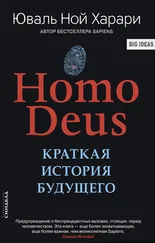You can already find much more extreme examples of external mediation in the geriatric wards of hospitals. Humanism fantasises about old age as a period of wisdom and awareness. The ideal elder may suffer from bodily ailments and weaknesses, but his mind is quick and sharp, and he has eighty years of insights to dispense. He knows exactly what’s what, and always has good advice for the grandchildren and other visitors. Twenty-first-century octogenarians don’t always look like that. Thanks to our growing understanding of human biology, medicine keeps us alive long enough for our minds and our ‘authentic selves’ to disintegrate and dissolve. All too often, what’s left is a collection of dysfunctional biological systems kept going by a collection of monitors, computers and pumps.
At a deeper level, as genetic technologies are integrated into daily life, and as people develop increasingly intimate relations with their DNA, the single self might blur even further, and the authentic inner voice might dissolve into a noisy crowd of genes. When I am faced by difficult dilemmas and decisions, I may stop searching for my inner voice, and instead consult my inner genetic parliament.
On 14 May 2013 actress Angelina Jolie published an article in the New York Times about her decision to have a double mastectomy. Jolie lived for years under the shadow of breast cancer, as both her mother and grandmother died of it at a relatively early age. Jolie herself did a genetic test that proved she was carrying a dangerous mutation of the BRCA1 gene. According to recent statistical surveys, women carrying this mutation have an 87 per cent probability of developing breast cancer. Even though at the time Jolie did not have cancer, she decided to pre-empt the dreaded disease and have a double mastectomy. In the article Jolie explained that ‘I choose not to keep my story private because there are many women who do not know that they might be living under the shadow of cancer. It is my hope that they, too, will be able to get gene-tested, and that if they have a high risk they, too, will know that they have strong options.’ 28
Deciding whether to undergo a mastectomy is a difficult and potentially fatal choice. Beyond the discomforts, dangers and financial costs of the operation and its follow-up treatments, the decision can have far-reaching effects on one’s health, body image, emotional well-being and relationships. Jolie’s choice, and the courage she showed in going public with it, caused a great stir and won her international acclaim and admiration. In particular, many hoped that the publicity would increase awareness of genetic medicine and its potential benefits.
From a historical perspective, it is interesting to note the critical role algorithms played in this case. When Jolie had to take such an important decision about her life, she did not climb a mountaintop overlooking the ocean, watch the sun set into the waves and attempt to connect to her innermost feelings. Instead, she preferred to listen to her genes, whose voice manifested not in feelings but in numbers. Jolie felt no pain or discomfort whatsoever. Her feelings told her: ‘Relax, everything is perfectly fine.’ But the computer algorithms used by her doctors told a different story: ‘You don’t feel anything is wrong, but there is a time bomb ticking in your DNA. Do something about it – now!’
Of course, Jolie’s emotions and unique personality played a key part too. If another woman with a different personality had discovered she was carrying the same genetic mutation, she might well have decided not to undergo a mastectomy. However – and here we enter the twilight zone – what if that other woman had discovered she carried not only the dangerous BRCA1 mutation, but another mutation in the (fictional) gene ABCD3, which impairs a brain area responsible for evaluating probabilities, thereby causing people to underestimate dangers? What if a statistician pointed out to this woman that her mother, grandmother and several other relatives all died young because they underestimated various health risks and failed to take precautionary measures?
In all likelihood, you too will make important decisions about your health in the same way as Angelina Jolie. You will do a genetic test, a blood test or an fMRI; an algorithm will analyse your results on the basis of enormous statistical databases; and you will then accept the algorithm’s recommendation. This is not an apocalyptic scenario. The algorithms won’t revolt and enslave us. Rather, the algorithms will be so good in making decisions for us that it would be madness not to follow their advice.
Angelina Jolie’s first leading role was in the 1993 science-fiction action film Cyborg 2 . She played Casella Reese, a cyborg developed in the year 2074 by Pinwheel Robotics for corporate espionage and assassination. Casella is programmed with human emotions, in order to blend better into human societies while pursuing her missions. When Casella discovers that Pinwheel Robotics not only controls her, but also intends to terminate her, she escapes and fights for her life and freedom. Cyborg 2 is a liberal fantasy about an individual fighting for liberty and privacy against global corporate octopuses.
In her real life, Jolie preferred to sacrifice privacy and autonomy for health. A similar desire to improve human health may well cause most of us to willingly dismantle the barriers protecting our private spaces, and allow state bureaucracies and multinational corporations access to our innermost recesses. For instance, allowing Google to read our emails and follow our activities would make it possible for Google to alert us to brewing epidemics before they are noticed by traditional health services.
How does the UK National Health Service know that a flu epidemic has erupted in London? By analysing the reports of thousands of doctors in hundreds of clinics. And how do all these doctors get the information? Well, when Mary wakes up one morning feeling a bit under the weather, she doesn’t run straight to her doctor. She waits a few hours, or even a day or two, hoping that a nice cup of tea with honey will do the trick. When things don’t improve, she makes an appointment with the doctor, goes to the clinic and describes the symptoms. The doctor types the data into the computer, and somebody up in NHS headquarters hopefully analyses this data together with reports streaming in from thousands of other doctors, concluding that flu is on the march. All this takes a lot of time.
Google could do it in minutes. All it needs to do is monitor the words Londoners type in their emails and in Google’s search engine, and cross-reference them with a database of disease symptoms. Suppose on an average day the words ‘headache’, ‘fever’, ‘nausea’ and ‘sneezing’ appear 100,000 times in London emails and searches. If today the Google algorithm notices they appear 300,000 times, then bingo! We have a flu epidemic. There is no need to wait till Mary goes to her doctor. On the very first morning she woke up feeling a bit unwell, and before going to work she emailed a colleague, ‘I have a headache, but I’ll be there.’ That’s all Google needs.
However, for Google to work its magic, Mary must allow Google not only to read her messages, but also to share the information with the health authorities. If Angelina Jolie was willing to sacrifice her privacy in order to raise awareness of breast cancer, why shouldn’t Mary make a similar sacrifice in order to fight epidemics?
This isn’t a theoretical idea. In 2008 Google actually launched Google Flu Trends, that tracks flu outbreaks by monitoring Google searches. The service is still being developed, and due to privacy limitations it tracks only search words and allegedly avoids reading private emails. But it is already capable of ringing the flu alarm bells ten days before traditional health services. 29
Читать дальше
Конец ознакомительного отрывка
Купить книгу












